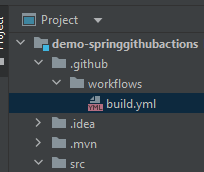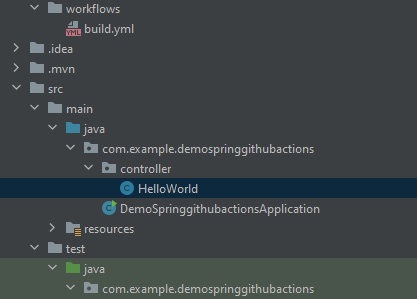Spring Boot – Continuous Integration Using GitHub Actions
Last Updated :
09 Jan, 2024
Let’s say we have two or more developers who are merging code into a single repository. There can be issues in merging code from different developers. So the Continuous Integration tools help in solving not just that but many other things like:
- Run an automated build after successful merging (like build, test code coverage, etc.).
- We can also automate deployment after proper checks.
- Not just that, these platforms also provide a way to communicate with others with comments to let’s say, solve a merging conflict or review a pull request.
- It also helps in running it on different OS.
One of the tools that we will be using here is GitHub Actions to accomplish our CI workflow. It is a powerful tool that can be utilized for continuous deployment as well.
Prerequisites:
- Keep IntelliJ Community(or related IDE)
- GitHub account
- JDK 11 and gitbash (or a related tool to push code)
Step-by-Step Implementation
Step 1: Let’s create a basic Spring boot project first
a). Go to https://start.spring.io/
- Project: Maven | Language: Java | Spring Boot: 2.7.14
- Project Metadata:
- Group: com.example | Artifact: demo-springgithubactions | Name: demo-springgithubactions
- Description: Demo project for Spring Boot with GitHub actions
- Package name: com.example.demo-springgithubactions
- Packaging: Jar | Java: 11 | Dependencies: Spring Web
b). Open in IntelliJ. Run the following command in the terminal
./mvnw clean install
c). Create following folders (….\demo-springgithubactions\.github\workflows\build.yml) and file (build.yml) which will be detected and used by github to run workflows using github actions.

d). Update the file with following code
name: Build a JAR in spring boot using springboot
on:
push:
branches:
– master
jobs:
build:
runs-on: ubuntu-latest
steps:
– name: Check out code
uses: actions/checkout@v2
– name: Set up JDK 11
uses: actions/setup-java@v1
with:
java-version: ’11’
– name: Build with Maven
run: mvn clean install
– name: Upload artifact for deployment job
uses: actions/upload-artifact@v2
with:
name: java-app
path: ‘${{ github.workspace }}/target/*.jar’
– name: Run Tests
run: mvn test
e). Create following folders (….\src\main\java\com\example\demospringgithubactions\controller\HelloWorld.java) and file (HelloWorld.java).

f). Update the file with following code.
Java
package com.example.demospringgithubactions.controller;
import org.springframework.web.bind.annotation.GetMapping;
import org.springframework.web.bind.annotation.RestController;
@RestController
public class HelloWorld {
@GetMapping
public String hello()
{
return "<!DOCTYPE html>\n"
+ "<html>\n"
+ "<head>\n"
+ "<style>\n"
+ "h1 {text-align: center;}\n"
+ "</style>\n"
+ "</head>\n"
+ "<body>\n"
+ "\n"
+ "<h1>Yaay!! you did it XD</h1>\n"
+ "\n"
+ "</body>\n"
+ "</html>\n";
}
}
|
g). Create following folders
(….\src\test\java\com\example\demospringgithubactions\DemoSpringgithubactionsApplicationTests.java) and file (DemoSpringgithubactionsApplicationTests.java).
 h). Update the file with following code.
h). Update the file with following code.
Java
package com.example.demospringgithubactions;
import static org.hamcrest.Matchers.containsString;
import static org.springframework.test.web.servlet.request.MockMvcRequestBuilders.get;
import static org.springframework.test.web.servlet.result.MockMvcResultMatchers.content;
import static org.springframework.test.web.servlet.result.MockMvcResultMatchers.status;
import com.example.demospringgithubactions.controller.HelloWorld;
import org.junit.jupiter.api.Test;
import org.junit.runner.RunWith;
import org.springframework.beans.factory.annotation.Autowired;
import org.springframework.boot.test.autoconfigure.web.servlet.WebMvcTest;
import org.springframework.test.context.junit4.SpringRunner;
import org.springframework.test.web.servlet.MockMvc;
@RunWith(SpringRunner.class)
@WebMvcTest(HelloWorld.class)
class DemoSpringgithubactionsApplicationTests {
@Autowired
private MockMvc mockMvc;
@Test
public void checkSuccessMessage() throws Exception
{
this.mockMvc
.perform(get("/"))
.andExpect(status().isOk())
.andExpect(content().string(
containsString("Yaay!! you did it XD")));
}
}
|
i). Run the code and verify if you are able to hit “http://localhost:8080/” end point with message dispalyed “Yaay!! you did it XD”.
Step 2: Let’s push our code to GitHub
git init
git add -A
git commit -m ‘Added my project’
git remote add origin <github-ssh-url>
git push -u -f origin main
Step 3: Go to Github actions tab and you will see the job running automatically

Share your thoughts in the comments
Please Login to comment...